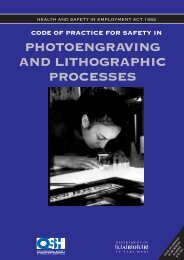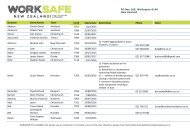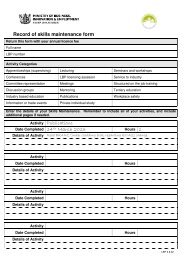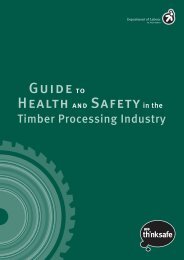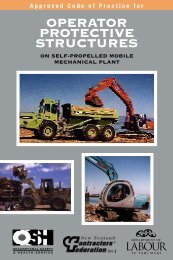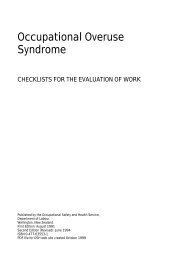Manual Handling in the Manufacturing Industry - Business.govt.nz
Manual Handling in the Manufacturing Industry - Business.govt.nz
Manual Handling in the Manufacturing Industry - Business.govt.nz
- No tags were found...
Create successful ePaper yourself
Turn your PDF publications into a flip-book with our unique Google optimized e-Paper software.
<strong>Manual</strong> <strong>Handl<strong>in</strong>g</strong> IN THE MANUFACTURING INDUSTRY
Published by <strong>the</strong> OccupationalSafety and Health Service of <strong>the</strong>Department of Labour,Well<strong>in</strong>gton, New ZealandAugust 1991ISBN-0-477-03488-8AcknowledgementThis booklet has been sourcedfrom material provided by <strong>the</strong>Occupational Safety and HealthDivision of <strong>the</strong> Department ofLabour, Victoria.P198/10,000/19912
Introduction"Manufactur<strong>in</strong>g" covers a widerange of <strong>in</strong>dustries <strong>in</strong>clud<strong>in</strong>g:textiles, cloth<strong>in</strong>g, footwear, motorvehicle assembly, food process<strong>in</strong>g,pulp and paper, wood productsand metal products.The most common manualhandl<strong>in</strong>g <strong>in</strong>juries that occur <strong>in</strong>manufactur<strong>in</strong>g <strong>in</strong>dustries are:spra<strong>in</strong>s and stra<strong>in</strong>s, back <strong>in</strong>juries,foot <strong>in</strong>juries and abdom<strong>in</strong>alhernias. Back pa<strong>in</strong> is a commonexperience. It can be caused oraggravated by manual handl<strong>in</strong>gactivities at work, and bodypostures that are adopted dur<strong>in</strong>gwork.This booklet aims to help thosepeople with little or nooccupational health expertise toidentify manual handl<strong>in</strong>g problemsand prevent <strong>in</strong>juries. Us<strong>in</strong>g <strong>the</strong>approach set out <strong>in</strong> <strong>the</strong> detailedpublication, <strong>Manual</strong> <strong>Handl<strong>in</strong>g</strong>:Guidel<strong>in</strong>es for <strong>the</strong> Workplace, itgives practical advice and showsthrough examples how manualhandl<strong>in</strong>g risks can be first beidentified, <strong>the</strong>n assessed andcontrolled <strong>in</strong> manufactur<strong>in</strong>g<strong>in</strong>dustries.3
Assess<strong>in</strong>g manualhandl<strong>in</strong>g tasksThis booklet follows <strong>the</strong> approach for identify<strong>in</strong>g, assess<strong>in</strong>g andcontroll<strong>in</strong>g manual handl<strong>in</strong>g risks that is set out <strong>in</strong> <strong>the</strong> publication<strong>Manual</strong> <strong>Handl<strong>in</strong>g</strong>: Guidel<strong>in</strong>es for <strong>the</strong> Workplace. The approach issummarised by <strong>the</strong> diagram below, but it should be remembered that bo<strong>the</strong>mployers and employees need to th<strong>in</strong>k about manual handl<strong>in</strong>g risks forpractical solutions to be found.Identifyrisks by consultationbetween employer andemployees (or <strong>the</strong>irrepresentatives).This checklist from <strong>the</strong>Guidel<strong>in</strong>es will help:Assessrisks and set prioritiesaccord<strong>in</strong>g to need and <strong>the</strong>range of solutionsavailable.› ›This worksheet from <strong>the</strong>Guidel<strong>in</strong>es will help:Controlrisks by:Redesign<strong>in</strong>g orelim<strong>in</strong>at<strong>in</strong>g <strong>the</strong> job/task;Mechanical aids; orTra<strong>in</strong><strong>in</strong>g and education.The worksheets from <strong>the</strong>Guidel<strong>in</strong>es will help:››Review and evaluateIs <strong>the</strong> solution work<strong>in</strong>g?DesignAny <strong>in</strong>itial or ongo<strong>in</strong>g design should consider manual handl<strong>in</strong>g risks.›5
Risk identificationMake yourself aware of potential manual handl<strong>in</strong>g problems by ask<strong>in</strong>g<strong>the</strong> follow<strong>in</strong>g questions.1. Is <strong>the</strong> work strenuous?2. Does anyone have to lift, carry, push or pull heavy or awkwardloads?3. Are mechanical aids, e.g. lift<strong>in</strong>g equipment, readily available andbe<strong>in</strong>g used?4. Can <strong>the</strong> system of work (job design) be improved, e.g. workloadspread evenly throughout <strong>the</strong> shift; heavy, tir<strong>in</strong>g tasks alternated withlight tasks?5. Is lift<strong>in</strong>g done at waist level, or is it high or low?6. Are <strong>the</strong> heaviest and/or most frequently used items stored at wais<strong>the</strong>ight?7. Can <strong>the</strong> work layout be improved e.g. more storage space to relievecramped conditions?8. Is all <strong>the</strong> equipment ma<strong>in</strong>ta<strong>in</strong>ed regularly and <strong>in</strong> good work<strong>in</strong>g order?9. What <strong>in</strong>juries or problems have already occurred <strong>in</strong> this area, thatmay be related to manual handl<strong>in</strong>g?l0. Is <strong>the</strong> workplace environment safe? e.g. are floor surfaces even andnon-slip, are pathways clear?11. What sort of tra<strong>in</strong><strong>in</strong>g and education programmes are provided?6
Pr<strong>in</strong>ciples ofprevent<strong>in</strong>g manualhandl<strong>in</strong>g <strong>in</strong>juries1. Reduce <strong>the</strong> amount of manual handl<strong>in</strong>g.2. Reduce <strong>the</strong> amount of bend<strong>in</strong>g, forward reach<strong>in</strong>g, andtwist<strong>in</strong>g <strong>in</strong> all tasks.3. Keep all equipment <strong>in</strong> good work<strong>in</strong>g order.4. Keep <strong>the</strong> work environment safe.5. Ensure that suitable tra<strong>in</strong><strong>in</strong>g and education <strong>in</strong> manualhandl<strong>in</strong>g is provided for all staff.These five basic pr<strong>in</strong>ciples will:• Help you identify which manual handl<strong>in</strong>g tasks pose a risk to healthand safety (risk identification); and• Make you aware of some of <strong>the</strong> possible solutions to common manualhandl<strong>in</strong>g problems (risk control). Some examples of <strong>the</strong>se pr<strong>in</strong>ciplesare illustrated <strong>in</strong> <strong>the</strong> follow<strong>in</strong>g pages.7
Reduce <strong>the</strong> amountof manual handl<strong>in</strong>g<strong>Manual</strong> handl<strong>in</strong>g is more than just lift<strong>in</strong>g. <strong>Manual</strong> handl<strong>in</strong>g <strong>in</strong>cludes:push<strong>in</strong>gpull<strong>in</strong>ghold<strong>in</strong>glift<strong>in</strong>g8
Example: Unload<strong>in</strong>g cartonsBy <strong>in</strong>creas<strong>in</strong>g <strong>the</strong> size and weight of <strong>the</strong> load and mechanis<strong>in</strong>g, manualhandl<strong>in</strong>g can be reduced and productivity <strong>in</strong>creased.Open<strong>in</strong>g 24 cartons of acommodity with a knife.Us<strong>in</strong>g a forklift and tilt<strong>in</strong>g mach<strong>in</strong>eto lift and open a 1 tonne(1000 kg) conta<strong>in</strong>er elim<strong>in</strong>ates <strong>the</strong>repetitive manual handl<strong>in</strong>g and <strong>the</strong>risk of knife <strong>in</strong>jury.Lift<strong>in</strong>g 24 x 20 kg cartons from apallet and carry<strong>in</strong>g <strong>the</strong>m to <strong>the</strong>storage bay.Lift<strong>in</strong>g and mov<strong>in</strong>g <strong>the</strong> 1 tonneconta<strong>in</strong>er with a hand-operatedforklift, makes <strong>the</strong> job a lot lessstrenuous and reduces <strong>the</strong> timespent on unload<strong>in</strong>g pallets.9
Example: Degreas<strong>in</strong>g metal componentsLift<strong>in</strong>g 30 kg baskets of metalcomponents and carry<strong>in</strong>g <strong>the</strong>m toand from a degreas<strong>in</strong>g mach<strong>in</strong>e.Us<strong>in</strong>g a hoist to lift <strong>the</strong> baskets onto <strong>the</strong> roller conveyor, elim<strong>in</strong>ates<strong>the</strong> heavy lift<strong>in</strong>g.The conveyor is on an angle, so that <strong>the</strong> baskets can be slid easily over<strong>the</strong> rollers to and from <strong>the</strong> degreas<strong>in</strong>g mach<strong>in</strong>e.10
Job rotationJob rotation can be used to reduce <strong>the</strong> amount of manual handl<strong>in</strong>g thateach employee does throughout <strong>the</strong> work shift. Job rotation can helpprevent spra<strong>in</strong>s and stra<strong>in</strong>s by provid<strong>in</strong>g employees with a change ofactivity.The ideal comb<strong>in</strong>ation of jobs <strong>in</strong>cludes a variety of sitt<strong>in</strong>g, stand<strong>in</strong>g andwalk<strong>in</strong>g activities.Each employee does a s<strong>in</strong>glerepetitive job over <strong>the</strong> whole workshift, e.g. an assembly task.Each employee has a variety ofjobs throughout <strong>the</strong> work shift, e.g.assembly, pack<strong>in</strong>g and mach<strong>in</strong><strong>in</strong>gtasks.Each job is designed so that it<strong>in</strong>cludes a variety of activities, e.g.1st class mach<strong>in</strong>ist • sett<strong>in</strong>g upmach<strong>in</strong>e • load<strong>in</strong>g mach<strong>in</strong>e •check<strong>in</strong>g mach<strong>in</strong>e • <strong>in</strong>spect<strong>in</strong>g parts• load<strong>in</strong>g parts to be taken away.11
A drum lifter makes mov<strong>in</strong>g andempty<strong>in</strong>g drums a lot easier andsafer.A drum tilt<strong>in</strong>g lever reduces <strong>the</strong>effort required <strong>in</strong> up-end<strong>in</strong>g filleddrums.Us<strong>in</strong>g a forklift to move a drumelim<strong>in</strong>ates <strong>the</strong> manual handl<strong>in</strong>grequired.For bulk handl<strong>in</strong>g of liquids, aconta<strong>in</strong>er system which istransported by forklift elim<strong>in</strong>ates<strong>the</strong> manual handl<strong>in</strong>g of drums.13
Example: Unload<strong>in</strong>g bags ofgranulesPlatformsHold<strong>in</strong>g <strong>the</strong> 30 kg bag of granuleswhilst empty<strong>in</strong>g <strong>the</strong> contentsslowly <strong>in</strong>to a cooker.The platform is <strong>the</strong>n raised. Theemployee stands on <strong>the</strong> steps andguides <strong>the</strong> granules but doesn'thave to hold <strong>the</strong> bag.14
LiftersA hydraulic or power-operatedlifter can be used to reduce <strong>the</strong>effort of mov<strong>in</strong>g By adjust<strong>in</strong>g <strong>the</strong>height of <strong>the</strong> lifter, <strong>the</strong> bags can beslid across to <strong>the</strong> lifter, ra<strong>the</strong>r thanlifted.The lifter can act as a platform forhold<strong>in</strong>g <strong>the</strong> bags whilst <strong>the</strong>contents are be<strong>in</strong>g emptied.Vacuum liftersVacuum lifters are commonly usedfor pick<strong>in</strong>g up awkward, heavyloads, and large flat sheets, e.g.metal, glass, chipboard.Unload<strong>in</strong>g 40 kg bags from apallet.An electrically-operated vacuumlifter elim<strong>in</strong>ates <strong>the</strong> heavy lift<strong>in</strong>g.The mechanical arm is guided by<strong>the</strong> employee.15
CounterbalancedequipmentEquipment that is heavy, or used cont<strong>in</strong>uously, can be counterbalanced toreduce <strong>the</strong> manual handl<strong>in</strong>g effort required, e.g. hose of <strong>the</strong> vacuumlifter, tools used on an assembly l<strong>in</strong>e.Irons used <strong>in</strong> <strong>the</strong> cloth<strong>in</strong>g <strong>in</strong>dustrycan be counterbalanced to reduce<strong>the</strong> effort of lift<strong>in</strong>g <strong>the</strong>mcont<strong>in</strong>uously.Tools that are used repetitively,such as drills and screwdrivers,can also be counterbalanced.16
HoistsEach <strong>in</strong>gredient is carried up <strong>the</strong> steps and fed <strong>in</strong> by hand.All <strong>the</strong> <strong>in</strong>gredients are put <strong>in</strong>to a hopper which is lifted with a hoist andemptied by hand. This reduces <strong>the</strong> hold<strong>in</strong>g and carry<strong>in</strong>g work required.17
Lift<strong>in</strong>g magnetsMagnets can be a useful aid <strong>in</strong> <strong>the</strong> manual handl<strong>in</strong>g of metal products,which are generally heavy and have sharp edges. They are used widely <strong>in</strong>sheet metal workshops, eng<strong>in</strong>eer<strong>in</strong>g workshops, <strong>the</strong> motor vehicle<strong>in</strong>dustry and <strong>the</strong> scrap metal <strong>in</strong>dustry. They are particularly useful forlift<strong>in</strong>g and stack<strong>in</strong>g steel plate and metal sheets, which are large andawkward to carry.This magnet is used with a hoist,to lift one sheet or block of metalat a time from a stack.These magnetic handles aredesigned for lift<strong>in</strong>g and mov<strong>in</strong>gs<strong>in</strong>gle sheets of metal.This magnet is used toge<strong>the</strong>r with a mobile crane to unload and transfermetal products up to 900 kg. It makes <strong>the</strong> job easier, safer and quicker.18
TurntablesLean<strong>in</strong>g over <strong>the</strong> pallet to load andunload boxes on <strong>the</strong> far side.A pallet hoop turntable allows <strong>the</strong>pallet to be rotated 360° andreduc<strong>in</strong>g <strong>the</strong> carry<strong>in</strong>g or bend<strong>in</strong>grequired — also provid<strong>in</strong>g toespace, to allow <strong>the</strong> load to be keptcloser to <strong>the</strong> body.Products be<strong>in</strong>g assembled on a l<strong>in</strong>efrequently need to be lifted andturned around.A rotat<strong>in</strong>g turntable on <strong>the</strong>assembly l<strong>in</strong>e, or rotat<strong>in</strong>g base on<strong>the</strong> product, elim<strong>in</strong>ates <strong>the</strong> need tolift, and <strong>the</strong> amount of bend<strong>in</strong>g andtwist<strong>in</strong>g.19
Reduce <strong>the</strong> amountof bend<strong>in</strong>g, forwardreach<strong>in</strong>g and twist<strong>in</strong>gDesign of equipmentand workstationsThe design of equipment andworkstations dictates, to a greatextent, <strong>the</strong> work postures and workmethods required. Use ofequipment that requires prolongedbend<strong>in</strong>g and twist<strong>in</strong>g posturesshould be avoided. Newequipment should ideally be testedand assessed by <strong>the</strong> employeesconcerned, prior to purchase.Professional ergonomic expertisemay also be required.Repetitive bend<strong>in</strong>g is required toempty components out of a crateand on to a conveyor belt.A spr<strong>in</strong>g-loaded base keeps <strong>the</strong>components at a convenient height.A forklift loads <strong>the</strong> crate on to a“tipper” platform, and <strong>the</strong> “tipper”is <strong>the</strong>n operated to keep <strong>the</strong>components at waist height.20
Employees often th<strong>in</strong>k of a better or easier way to do a job. There aremany examples where, by work<strong>in</strong>g toge<strong>the</strong>r with<strong>in</strong> <strong>the</strong> organisation,employees and management have been able to come up with somesuccessful "<strong>in</strong>-house" solutions to manual handl<strong>in</strong>g problems.Pack<strong>in</strong>g a heavy weld<strong>in</strong>g mach<strong>in</strong>eon <strong>the</strong> floor.A custom-built frame attached to<strong>the</strong> conveyor belt reduces <strong>the</strong>amount of lift<strong>in</strong>g and bend<strong>in</strong>grequired.The drill<strong>in</strong>g is done on an unstablesurface <strong>in</strong> an awkward position.A custom-built frame whichreduces <strong>the</strong> amount of hold<strong>in</strong>g andbend<strong>in</strong>g, forward reach<strong>in</strong>g, andtwist<strong>in</strong>g required.21
Seat<strong>in</strong>gSitt<strong>in</strong>g for prolonged periods <strong>in</strong> awkward postures whilst engaged <strong>in</strong>manual handl<strong>in</strong>g activities, e.g. <strong>in</strong>spection, light assembly tasks, can leadto back pa<strong>in</strong> or aggravate an exist<strong>in</strong>g back problem. Good seat<strong>in</strong>g is oftenneglected <strong>in</strong> <strong>the</strong> manufactur<strong>in</strong>g <strong>in</strong>dustry. Stools (kitchen-type) and castoutoffice chairs are frequently provided. These are <strong>in</strong>appropriate <strong>in</strong> mostcases because <strong>the</strong>y are not <strong>the</strong> right height and do not offer good backsupport. The two most important features to look for <strong>in</strong> a chair are:height adjustability and a good lumbar (low back) support. Wherepossible, it is preferable for people to be able to change between sitt<strong>in</strong>gand stand<strong>in</strong>g postures as <strong>the</strong>y wish.Sitt<strong>in</strong>g with a bent back on a stoolwhich does not provide any backsupport or adequate foot support.At this workstation <strong>the</strong> employee isable to change between sitt<strong>in</strong>g andstand<strong>in</strong>g postures.Sitt<strong>in</strong>g with a bent back on akitchen-type chair which is too lowand does not provide adequate lowback support.22This chair is height adjustable andprovides good low back support.
Work layoutThis work layout requires forwardbend<strong>in</strong>g and reach<strong>in</strong>g over <strong>the</strong>conveyor belt, as well as turn<strong>in</strong>g topack <strong>the</strong> product <strong>in</strong> boxes.When <strong>the</strong> work is close to <strong>the</strong> body<strong>the</strong> employee can sit or stand witha straight back.Inadequate leg room under <strong>the</strong>conveyor belt forces <strong>the</strong> employeeto sit side-on <strong>in</strong> a twisted position.Adequate leg room under <strong>the</strong>conveyor allows <strong>the</strong> employee tosit with a straight back.23
Get <strong>the</strong> work height right!The ideal work height depends on <strong>the</strong> activity. Generally, lift<strong>in</strong>g shouldbe done <strong>in</strong> front of <strong>the</strong> body at between shoulder and mid-thigh height —to reduce <strong>the</strong> amount of bend<strong>in</strong>g and twist<strong>in</strong>g of <strong>the</strong> back.When <strong>the</strong> work height is too high, aids such as steps, stools, platforms,ladders or stairs should be provided, to reduce backward bend<strong>in</strong>g andtwist<strong>in</strong>g actions of <strong>the</strong> sp<strong>in</strong>e.24
When <strong>the</strong> work height is too low, aids such as tables, chairs, platformsand adjustable conveyor systems should be provided, to reduce <strong>the</strong>amount of forward bend<strong>in</strong>g and twist<strong>in</strong>g of <strong>the</strong> back required.Scissor-lift platform and table.Height-adjustable conveyorsystem.25
Use a table.Use a chair.26
Work<strong>in</strong>g close to ground levelrequires bend<strong>in</strong>g and twist<strong>in</strong>g, andcan be fatigu<strong>in</strong>g.Us<strong>in</strong>g a small stool on castors —or a box — may reduce <strong>the</strong> effort,as well as <strong>the</strong> bend<strong>in</strong>g andtwist<strong>in</strong>g.This <strong>in</strong>spection task <strong>in</strong>volvesrepetitive forward reach<strong>in</strong>g. Thereis static load<strong>in</strong>g of <strong>the</strong> neck, armsand back.The forearm supports and <strong>the</strong> backsupport of <strong>the</strong> chair reduce <strong>the</strong>static load<strong>in</strong>g, and reduce <strong>the</strong>amount of forward reach<strong>in</strong>grequired.27
StorageAll frequently used components should be stored with<strong>in</strong> easy reach, i.e.with<strong>in</strong> 400 mm of <strong>the</strong> body. When large numbers of components need tobe on hand, e.g. assembly tasks, <strong>the</strong>n <strong>the</strong> method of storage needsconsideration.Wire, tub<strong>in</strong>g and hose can be stored on reels and fixed at a convenien<strong>the</strong>ight.A foot-operated conveyor systembr<strong>in</strong>gs <strong>the</strong> components up to aconvenient height.Components can be stored onrotat<strong>in</strong>g turntables.28
Keep all equipment<strong>in</strong> good work<strong>in</strong>g orderUnexpected or forceful actions required due to faulty or poorlyma<strong>in</strong>ta<strong>in</strong>ed equipment can lead to stra<strong>in</strong>s and <strong>in</strong>juries. All equipmentshould be ma<strong>in</strong>ta<strong>in</strong>ed on a regular basis and repaired promptly whennecessary.What are <strong>the</strong> ma<strong>in</strong>tenance proceduresat your workplace?Is equipment and mach<strong>in</strong>ery ma<strong>in</strong>ta<strong>in</strong>edto a checklist?29
Keep <strong>the</strong> workenvironment safeSlips, trips and falls dur<strong>in</strong>g manual handl<strong>in</strong>g activities can lead toserious <strong>in</strong>jury. Uneven or slippery floor surfaces, trail<strong>in</strong>g hoses andcords, and obstacles on <strong>the</strong> ground are common hazards. Pathways,access ways and work areas need to be marked and kept clear so thatcollisions can be avoided. <strong>Manual</strong> handl<strong>in</strong>g <strong>in</strong>juries can be avoided byregular ma<strong>in</strong>tenance and housekeep<strong>in</strong>g procedures.Push<strong>in</strong>g a trolley over an uneven surface can require a forceful action.Torn floor cover<strong>in</strong>gs are also a tripp<strong>in</strong>g hazard.30
Provide suitableeducation and tra<strong>in</strong><strong>in</strong>gEmployees should get appropriate education and tra<strong>in</strong><strong>in</strong>g <strong>in</strong> manualhandl<strong>in</strong>g techniques so that <strong>the</strong>y are able to choose <strong>the</strong> best technique foreach particular situation. Tra<strong>in</strong><strong>in</strong>g and education is more than teach<strong>in</strong>gpeople how to lift correctly. The broad aims of tra<strong>in</strong><strong>in</strong>g and educationare:1. To ensure that each employee has <strong>the</strong> skills and knowledge to be ableto do <strong>the</strong>ir job safely.2. To ensure that each employee has an understand<strong>in</strong>g of <strong>the</strong> pr<strong>in</strong>ciplesof back care and <strong>the</strong> prevention of <strong>in</strong>jury, which is relevant to <strong>the</strong>irparticular situation.3. To ensure that each employee has an understand<strong>in</strong>g of <strong>the</strong> manyfactors that can cause back pa<strong>in</strong> and <strong>in</strong>jury.4. To encourage each employee to take an active role <strong>in</strong> <strong>the</strong> preventionof manual handl<strong>in</strong>g <strong>in</strong>juries at work.Us<strong>in</strong>g mechanical aids when <strong>the</strong>yare available.Us<strong>in</strong>g <strong>the</strong> correct lift<strong>in</strong>g methodwhen possible by: bend<strong>in</strong>g <strong>the</strong>knees, keep<strong>in</strong>g <strong>the</strong> back straightand keep<strong>in</strong>g <strong>the</strong> load close to <strong>the</strong>body.31




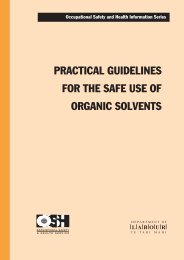
![Task analysis worksheet [161 KB PDF] - Business.govt.nz](https://img.yumpu.com/51400981/1/190x135/task-analysis-worksheet-161-kb-pdf-businessgovtnz.jpg?quality=85)

